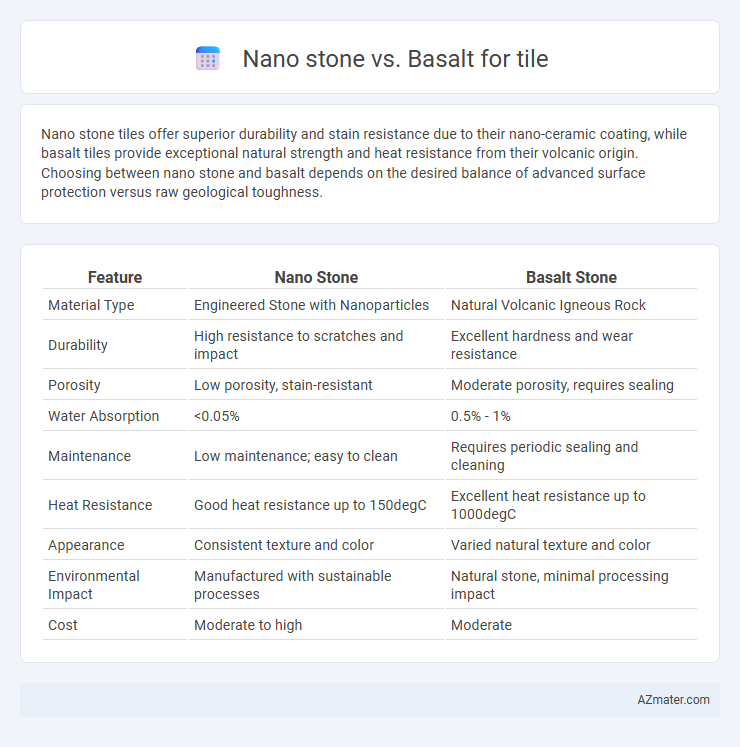Nano stone tiles offer superior durability and stain resistance due to their nano-ceramic coating, while basalt tiles provide exceptional natural strength and heat resistance from their volcanic origin. Choosing between nano stone and basalt depends on the desired balance of advanced surface protection versus raw geological toughness.
Table of Comparison
| Feature | Nano Stone | Basalt Stone |
|---|---|---|
| Material Type | Engineered Stone with Nanoparticles | Natural Volcanic Igneous Rock |
| Durability | High resistance to scratches and impact | Excellent hardness and wear resistance |
| Porosity | Low porosity, stain-resistant | Moderate porosity, requires sealing |
| Water Absorption | <0.05% | 0.5% - 1% |
| Maintenance | Low maintenance; easy to clean | Requires periodic sealing and cleaning |
| Heat Resistance | Good heat resistance up to 150degC | Excellent heat resistance up to 1000degC |
| Appearance | Consistent texture and color | Varied natural texture and color |
| Environmental Impact | Manufactured with sustainable processes | Natural stone, minimal processing impact |
| Cost | Moderate to high | Moderate |
Introduction to Nano Stone and Basalt Tiles
Nano stone tiles feature advanced nanotechnology that enhances durability, water resistance, and stain protection, making them ideal for modern flooring solutions. Basalt tiles, derived from volcanic rock, offer natural strength, heat resistance, and a unique textured appearance favored in both indoor and outdoor applications. Comparing nano stone and basalt tiles reveals differences in manufacturing, surface properties, and performance suited for various architectural and design needs.
Composition and Formation Differences
Nano stone tiles consist of engineered composite materials, often incorporating nanomaterials to enhance durability, hardness, and scratch resistance, whereas basalt tiles are natural volcanic igneous rocks formed from the rapid cooling of lava. The microstructure of nano stone allows for precise control over physical properties due to its synthetic formation process, contrasting with basalt's crystalline, fine-grained texture created through natural geological processes. These fundamental differences in composition and formation result in distinct characteristics affecting tile performance, longevity, and aesthetic appeal.
Aesthetic Appeal: Colors and Patterns
Nano stone tiles offer a sleek, modern aesthetic with a smooth surface and uniform color palette ideal for minimalist designs, while basalt tiles present a natural, rugged texture featuring rich, earthy tones and unique vein patterns that enhance rustic or industrial interiors. The vibrant, consistent hues of nano stone complement contemporary spaces, whereas basalt's varied shades of dark gray, black, and brown add depth and character to natural-themed environments. Both materials provide distinctive visual appeal, with nano stone excelling in refined elegance and basalt in organic authenticity.
Durability and Strength Comparison
Nano stone tiles exhibit exceptional durability due to their dense molecular structure, which enhances resistance to scratches, stains, and impact. Basalt tiles are renowned for their natural strength and toughness, with high compressive strength making them ideal for heavy-duty flooring applications. When comparing durability and strength, basalt generally outperforms nano stone in extreme load-bearing scenarios, while nano stone offers superior surface hardness and longevity in everyday use.
Water Absorption and Stain Resistance
Nano stone tiles exhibit lower water absorption rates, typically below 0.1%, making them highly resistant to moisture infiltration compared to basalt tiles, which generally have water absorption levels around 0.5%. The dense nanoparticle structure of nano stone enhances stain resistance by preventing liquid penetration and facilitating easier cleaning. Basalt tiles, while durable and naturally water-resistant, may still absorb stains more readily due to their porous volcanic origin.
Slip Resistance and Surface Texture
Nano stone tiles exhibit a highly refined surface texture that enhances slip resistance by minimizing surface irregularities and improving grip. Basalt tiles naturally possess a coarse texture, contributing to excellent slip resistance, especially in wet or outdoor environments. Both materials offer durable options, but basalt's inherently rough surface provides superior traction compared to the smoother finish of nano stone.
Maintenance and Cleaning Requirements
Nano stone tiles offer superior stain resistance and require minimal maintenance due to their non-porous surface, making cleaning quick and efficient with just mild soap and water. Basalt tiles, while durable, are naturally porous and need regular sealing to prevent moisture absorption and staining, increasing maintenance efforts over time. The difference in surface properties directly influences the frequency and type of cleaning products needed, with nano stone providing a more hassle-free experience.
Cost and Availability
Nano stone tiles typically cost more than basalt due to advanced manufacturing processes and limited production scale, affecting overall budget considerations. Basalt is widely available and sourced directly from natural quarries, making it more cost-effective and easier to procure for large projects. The availability of basalt in various regions ensures faster delivery times and lower transportation expenses compared to nano stone alternatives.
Applications in Residential and Commercial Spaces
Nano stone tiles offer exceptional durability and stain resistance, making them ideal for high-traffic commercial areas such as shopping malls and office lobbies, while their sleek, modern appearance complements contemporary residential interiors like kitchens and bathrooms. Basalt tiles, known for their natural strength and slip resistance, are frequently chosen for outdoor residential patios and commercial flooring in restaurants or public plazas where safety and longevity are critical. Both materials provide versatile solutions, with nano stone favored for its advanced technological properties and basalt valued for its robust, natural aesthetic and performance in diverse environments.
Environmental Impact and Sustainability
Nano stone tiles often boast enhanced durability and require less frequent replacement, reducing material waste over time, while basalt tiles are naturally abundant and typically require minimal processing, leading to a lower carbon footprint during production. Basalt's extraction and processing involve lower energy consumption compared to the synthetic manufacturing methods sometimes employed for nano stone, favoring environmental sustainability. Both materials offer eco-friendly options, but basalt's natural origin and reduced processing make it a more sustainable choice for environmentally conscious tiling projects.

Infographic: Nano stone vs Basalt for Tile
 azmater.com
azmater.com